An Illusion of Going Somewhere
Copyright © 2004 by Richard S. Platz
All Rights Reserved
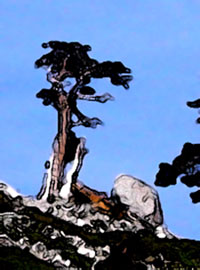
Boulder Creek, Foster Lake, Union Creek Backpack
Trinity Alps Wilderness
July 7-11, 2004
"She looks steep"
Nancy and Mr. Popper are hiking companions. So are they domestic
partners, significant others, paramours, and, if one believes
in such things, soul mates. Barbara and I had backpacked on numerous
occasions with Mr. Popper, but, alas, had never shared the pleasures
and pains with Nancy. This we resolved to change.
Bargaining began at the end of May as Mr. Popper and I dickered
over a mutually acceptable destination for the first week of July.
I argued for someplace new. Mr. Popper leaned toward familiar
grandeur. No nuance was left unturned. No ramification escaped
scrutiny. Elevations and trail lengths were considered in detail,
and so were topography, geology, forest cover, trailheads, campsite
capacities, and assembly logistics. Negotiations waxed and waned
for the better part of June.
Duck and Eaton Lakes in the Russian Wilderness, and Lion and
Foster Lakes in the Trinity Alps, were the final contenders. Barbara
and I had camped at Duck and Eaton Lakes twice, but neither Mr.
Popper nor Nancy ever had. Magnanimously we offered to return
there and share with them the magnificence of those jewels set
in the rough granite. I printed out a trail profile of the Duck
Lakes trail. Mr. Popper studied the profile, rubbing his chin.
"She looks steep."
Though the trail to Lion Lake was longer and steeper, at least
its evils were known. Mr. Popper had been to Lion on three separate
occasions and was comfortable with it. The terraced and glacier-polished
granite landscape was magnificently familiar. In 2000, even as
their romance blossomed, he and Nancy had visited Lion and Foster
Lakes, which lie a half mile apart on opposite sides of the 7000-foot
divide separating the Boulder and Union Creek drainages.
Barbara and I had stayed at Foster Lake in September of 2000,
our last backpack before my hip replacement. I had barely managed
to limp out propped between two trembling hiking sticks. Returning
with a healthy titanium hip was enticing.
So we settled on Lion and Foster Lakes.
Negotiations shifted to timing. Nancy's sister Margot
would be arriving from Sedona for the Fourth of July. Their father
would join them. Nancy wanted them to view the fireworks from
a boat on the Humboldt Bay and then spend a day sightseeing in
Weaverville. The earliest they could meet us for the backpack
would be Wednesday evening. Margot had agreed to join us on the
hike.
That was fine with us. We would spend the holiday clearing brush
away from the cabin and outbuildings at our land in Oregon. We
agreed to meet at the Boulder Creek crossing four or five miles
up the trail, where water abounded and the campsite would accommodate
five. The following day we would lug our packs up the two thousand
feet to Lion or Foster Lake. Which lake was left for future
bargaining.
Tuesday, before dawn, the loud, bawdy cries of Sandhill Cranes
gave way to the soft, sweet call of a Mourning Dove. In the fog
rising from the water Barbara watched the cranes and elk until
her arms grew tired from the weight of the binoculars. Ground
squirrels (which Barbara calls "bubonics") chased each
other up and down the trees. The sun rose clear and warm.
Driving south from Oregon, we headed for the Boulder Lake trailhead
with the sun blazing through the windshield, irritating even with
the air-conditioning blowing full-blast. It seemed inordinately
hot even at the 5000-foot summit of Scott Mountain. We grew increasingly
cranky as the heat eroded our strength. Later we would learn that
the temperature had set a record 108 degrees in Redding.
Just south of the Coffee Creek bridge on Highway 3, a graveled
forest road climbs 11 miles west to the Boulder Creek trailhead.
Half-way up, as we rounded a curve gouged into the steep, forested
hillside, we startled a bear in the road. As the van bore down,
the bear loped across to the slope and scrambled up the sheer
bank. Round and brown and healthy, but not large as bears go,
it weighed maybe 200 pounds. Probably an adolescent. Powerful
muscles rippled beneath its sleek fur. The bear took only a few
seconds to scale the steep slope and disappeared into the brush
above us.
At 5800 feet, the parking area at the Boulder Lake trailhead
was broad and wide, scraped flat from a rounded ridgetop in the
midst of a stand of tall red firs and spread with white gravel.
A steel gate blocks the old logging road that once continued on
to an upper parking lot at a log landing a quarter mile higher.
The trail now follows the old road.
We arrived in the late afternoon, tired, hungry, and drained
by the valley heat. A dozen middle-aged dayhikers, returning from
Boulder and Little Boulder Lakes, were loading their vehicles.
I asked about mosquitoes. One of their group had encountered mosquitoes
when he hiked into the lingering snow beneath the towering headwall
at the south end of Boulder Lake, but otherwise the trails were
clear and bug-free. No one was camping at either lake.
We deployed our folding chairs on a small forested knoll above
the parking lot and ate store-bought sandwiches. The place grew
eerily familiar. Half-remembered specters of days and deeds long
past lurked in the shadows like old dreams. Two tired backpackers
momentarily broke the spell as they descended the final hundred
yards to their car and departed. As their motor died away, we
began to remember. In this same clearing we had eaten supper on
our last trip four years earlier when my hip ground bone on bone.
A year or two before that, Mr. Popper and I had backpacked in
to Little Boulder Lake from this parking lot for a total lunar
eclipse. After witnessing the unexpected barbaric slaughter of
a stag in the lake next morning, we had chanced upon the untended
trailer needed by the hunters to haul out their prey. Seventeen
years ago, shortly after Barbara and I first met, the steep primitive
road circling our knoll had been open to the upper parking area.
Barbara had driven in to meet me at Boulder Lake at the end of
my solo backpack up Sugar Pine Creek, cross-country over to Lion
Lake, then down to Bolder Lake. Alone and frightened, she had
rattled, banged, and bounced her precious Honda up the rocky,
rutted road, punching a hole in the radiator in the process. And
twenty-five years ago I had first climbed up the brutally steep
Boulder Creek trail to Boulder Lake, and on learning there was
a shorter way in, had hitched a ride out through this place in
the back of a pickup truck. Like swatches of threadbare cloth,
so many years were layered one upon the other.
The shadows lengthened. Only two other vehicles remained in the
parking lot, a white Blazer marked with the California Fish and
Game logo and a similar green Forest Service SUV. We toyed with
this concurrence, assuming one was driven by a biologist and one
by a ranger. The ranger male. The biologist female. Yin and yang.
As evening fell, we speculated on what they might be doing in
the wilderness together, alone.
Twilight crept in early beneath the tall red firs, while the
mountains to the east still caught the brilliant last rays of
sunlight. We walked down a steep spur road on the east side of
the ridge as far as a stream crossing and were rewarded with views
of the sunlit granite massif above Little Boulder Lake. In the
dwindling alpenglow we readied our packs and fell asleep in the
van. That night, while Barbara slept, I heard coyotes howling
close by.
We arose with first light Wednesday morning. The day promised
again to be hot. After breakfast we began to sweat in the sun's
first rays as we stuffed our backpacks propped against the van.
On the trail by 8:30, we climbed the old logging road through
the tall timber, past the abandoned landing where Barbara's Honda
had bled antifreeze, then ascended southward up the east side
of a long moraine. The trail rose moderately, mostly in forest
shade, before cutting abruptly west to climb more steeply over
the moraine ridge and into the Boulder Creek cirque. The forest
grew sparse and duff gave way to white granite scree, rock, and
boulders. A little more than a mile from our van, a signed trail
forked left to Little Boulder Lake, which drains directly into
Coffee Creek east of the Boulder Creek drainage. We took the right
fork toward Boulder Lake.
Shortly we crested the rocky divide at 6380 feet, almost 600
feet above our van. This would be the high point of our day. By
evening we would descend a thousand feet to the Boulder Creek
crossing at 5380 feet, 420 feet below the van. Carefully
we descended the steep, rocky, scree-covered path to a triple
trail junction on the forested north shore of Boulder Lake. Here
at 6100 feet the Poison Canyon trail headed south along the lake's
east shore, and the Lion Lake trail continued west.
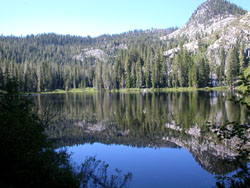 The
lake appeared deserted. In no hurry, we hoisted off our packs
and stretched. Barbara found a path through the wild azaleas to
the water's edge and took photos of the granite dome headwall
reflected in the lake's still waters. I climbed the gently terraced
east shore in search of a private place, musing that in the wilderness,
all the world is a toilet, and each of us a petty player recycling
nutrients through the topsoil's thin biological stage. The
lake appeared deserted. In no hurry, we hoisted off our packs
and stretched. Barbara found a path through the wild azaleas to
the water's edge and took photos of the granite dome headwall
reflected in the lake's still waters. I climbed the gently terraced
east shore in search of a private place, musing that in the wilderness,
all the world is a toilet, and each of us a petty player recycling
nutrients through the topsoil's thin biological stage.
The Lion Lake trail crossed the stream flowing north out of Boulder
Lake, which we hopped across on large, dry rocks. The maps gave
the outlet stream no name, but it joined Boulder Creek two mile
north, about half-way to Coffee Creek.
"Why don't they call it ‘the East Fork of Boulder Creek'?"
I wanted to know. Boulder Creek itself originates at Cub Wallow,
the valley two miles southwest of where we stood. Another unnamed
perennial stream flows down from Lion and Conway Lakes west of
Cub Wallow, which should by all rights be called "the West
Fork of Boulder Creek," but is not. "Or why not call
the main stream ‘Cub Wallow Creek' and this one ‘Boulder
Creek'?" But, of course, no one paid me any mind.
We intended to spend the night at the Boulder Creek ("Cub
Wallow Creek") trail crossing, only about a mile due west.
But to get there, the Lion Lake trail had to contour three miles
north, west, and south high on the moraine separating the two
streams. Neither of us has ever liked this segment of trail, even
though the views are spectacular over the Coffee Creek valley
to the naked rock dome of Billy's Peak dominating the opposite
slope. For one thing, it always seemed longer than three
miles. A lot longer. For another, the tread constantly
rises and falls, randomly, unnecessarily, and becomes exposed,
steep, rough, rocky, narrow, and slippery in its final descent
through thick, snagging brush to Boulder Creek. In the brush,
the day was hot and windless, and mosquitoes salivated at our
sweaty scent before pouncing.
We encountered a group of backpackers puffing up the trail from
Boulder Creek and swatting mosquitoes. They turned out to be the
fabled Biologist and the Ranger, about whom folk songs longed
to be written. Actually, they had brought her brother in for a
pleasant, uneventful backpack up to Lion Lake. A family outing.
Not a wilderness bacchanal. Not even government business. So much
for folk songs.
When at long last we arrived at the Boulder Creek crossing, Barbara
was too weary and irritable to sit down amid the bugs to take
off her boots. Instead, she splashed across with boots on, but
slipped on the wet rocks and went down on all fours in mid-stream.
There for a terrible moment she teetered like a giant tortoise,
in danger of toppling over pack-first into the swirling, calf-high
water and soaking everything. Still strapped to my own pack, I
watched helplessly from the bank behind. Slowly Barbara regained
her purchase, steadied herself, and pushed herself upright, arms
and legs dripping, but unhurt. In a showing of solidarity, I slogged
across the stream in my own hiking boots.
On the opposite bank, the trail followed the alder-lined creek
downstream as the deep glacial valley narrowed. We left the trail
and squished uphill two hundred feet to a cozy little campsite
in a grove of tall conifers with an almost-level tent site and
a large fire ring. Everywhere else the terrain tilted steeply
down to the creek. Dropping our packs, we peeled off our shoes
and socks, poured out the water, and laid them out to dry on the
rough, rounded granite sculptures studding the open duff and low
brush below us. We wiggled our bare toes in the sun and ate lunch.
It was just after noon and growing hot.
We scouted the area and found only one prime tent site, uncomfortably
close to the developed fire ring, where we had camped before.
Scattered amidst the boulders, grass, and short groundcover were
several other open areas, marginally level, which were, if not
elegant, adequate for sleeping the night. We tormented over whether
to commandeer the best spot for ourselves. What would Mother Theresa
have done had she been the first to arrive? Or Master Po?
What would Mr. Popper do? Ah, therein lay the key. We easily
concurred that Mr. Popper would certainly have grabbed the best
site for himself in a heartbeat. And besides, we did not expect
our compatriots for another three or four hours, if they
managed to show up at all. Guilt assuaged, we set up the tent
on the prime site and strung our hammocks between the best trees
nearby.
As the afternoon grew hot, we languished in our hammocks or else
sprawled in the shade, shooing away a few curious deer. Down along
the creek, Barbara heard the beautiful rolling trills of a Swainson's
Thrush. The wilderness holds no mirrors. Or at least not the literal,
silvered-glass instruments that reflect ancestral faces of old
age and impending death. This explains in part the rejuvenating
tonic of feral lands. There, like cats, gazing outward only, we
steadfastly refuse to recognize our own reflections. In the song
of the thrush we hear instead reverberations of our own strength
and youth and vitality.
Our reverie was broken sooner than expected. Around four o'clock
a lone young backpacker climbed up the slope from the creek. It
turned out to be Aaron, the son of backpacking friends, whom we
had watched grow as he accompanied his parents on group backpacks
over the years. In his early twenties, bright and fit, Aaron brimmed
with promise and potential, still decades away from the ugly realization
that nothing will work out. He now lives next door to Mr. Popper
and Nancy, and Mr. Popper had persuaded him to drive them over
in his four-wheel-drive Isuzu. None of us could figure out why
he enjoyed spending time with a wizened horde of senior citizens.
But he genuinely seemed to.
We moseyed on down to the creek with him to watch the other members
of the expedition straggle in. Nancy's sister, Margot, had already
waded across and was retying her boot laces. We introduced ourselves.
Mr. Popper and Nancy, boots in hand, splashed through the cold,
swift current. They had spent the previous night 4000 feet below
at the Trinity River Campground, tossing and turning in the unseasonable
heat.
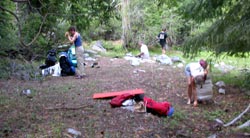 Without
a grumble, the newcomers selected suitable sites and set up their
tents. Mr. Popper uttered a muffled yelp as he plunged briskly
in the creek's icy waters. No one joined him. I passed around
a flask of cheap Amaretto di Santo. Mr. Popper concocted for his
squad a batch of Mountain Margaritas, which, because the snowfields
were beyond reach, they drank neat. After the long hike, a few
belts of alcohol infused the fellowship with a thick-tongued enthusiasm.
We muddled through dinner, then lay back in hammocks around the
campfire and palavered, swatting an occasional mosquito. Without
a grumble, the newcomers selected suitable sites and set up their
tents. Mr. Popper uttered a muffled yelp as he plunged briskly
in the creek's icy waters. No one joined him. I passed around
a flask of cheap Amaretto di Santo. Mr. Popper concocted for his
squad a batch of Mountain Margaritas, which, because the snowfields
were beyond reach, they drank neat. After the long hike, a few
belts of alcohol infused the fellowship with a thick-tongued enthusiasm.
We muddled through dinner, then lay back in hammocks around the
campfire and palavered, swatting an occasional mosquito.
As soon as it grew dark, we bid the others good night and crawled
into our tent in preparation for an early start the next morning.
But sleep was slow to come, kept at bay by the conversation and
occasional chortle from the nearby campfire. Thus did we discover
the true consequences of commandeering the best tent site at the
social hub. Karma, no?
We awoke with first light Thursday and quietly built a fire,
heated water, then sipped tea and mocha in our hammocks. By the
time we ate breakfast, the others had arisen. We explained that
we wanted to do most of our climbing before the heat of the day.
Mr. Popper agreed that the tent sites were limited at Lion Lake,
and that we should probably hike over the divide to Foster Lake.
The distance was less than two miles as the crow flies, but more
like three trail miles. The problem would be the 2000-foot climb
up to the divide, much of it in the full sun. Still, we spent
a leisurely morning packing up.
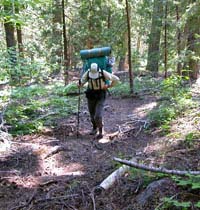 Around
10:30, as the others were just beginning to take down their tents,
we headed out. We would keep in touch with radios. The trail followed
willow-choked Boulder Creek north for a quarter mile to a junction
with the Lion Lake Trail fifty feet below our campsite. The trail
elbowed west to climb the forested slope, beginning in abrupt
switchbacks interspersed with impossibly steep stretches through
brush and fallen timber. Immediately we began to sweat and suck
down deep breaths. The day grew hot as we climbed. After 800 long
feet of elevation gain we climbed over a ridge into the upper
Boulder Creek basin and the grade eased. Through the thinning
trees a vista opened. Above us, on the north slope, loomed the
ragged spires and cleavers of Sugar Pine Butte. To the south blazed
a roiling sea of granite, frozen in time. A mile or so to the
west we would climb through a pass between Sugar Pine Butte and
the varnished granite summits above Cub Wallow. Below us lay a
vast canyon of glacier-polished granite. It was difficult to keep
our eyes on the trail. Around
10:30, as the others were just beginning to take down their tents,
we headed out. We would keep in touch with radios. The trail followed
willow-choked Boulder Creek north for a quarter mile to a junction
with the Lion Lake Trail fifty feet below our campsite. The trail
elbowed west to climb the forested slope, beginning in abrupt
switchbacks interspersed with impossibly steep stretches through
brush and fallen timber. Immediately we began to sweat and suck
down deep breaths. The day grew hot as we climbed. After 800 long
feet of elevation gain we climbed over a ridge into the upper
Boulder Creek basin and the grade eased. Through the thinning
trees a vista opened. Above us, on the north slope, loomed the
ragged spires and cleavers of Sugar Pine Butte. To the south blazed
a roiling sea of granite, frozen in time. A mile or so to the
west we would climb through a pass between Sugar Pine Butte and
the varnished granite summits above Cub Wallow. Below us lay a
vast canyon of glacier-polished granite. It was difficult to keep
our eyes on the trail.
As we hiked steadily, gazing from Thumb Rock in the distance
in the south along the rim to the towering snow-bearded summits
ahead, Aaron caught up to us. Chatting, we ambled along for a
while. But youth grows impatient, and Aaron moved on at a rapid
clip despite his heavy pack.
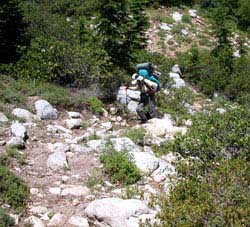 At
a stream crossing in a broad, wet meadow, the trail turned north
and began climbing an exposed slope of brush, talus, and granite
rocks and boulders. The path was steep as it zig-zagged ever upward
amid huge rocks and manzanita. Only a few trees cast meager patches
of shade. Occasionally the trail rose through a muddy seep choked
with alder and willows. We finally stopped for lunch at an open
area with a small stream. Aaron had backtracked to meet us there
because he had run out of water. We lunched together and pumped
water, sharing our cheese and cashews with him, because the only
snack food he was carrying was Mr. Popper's Milano cookies. Mr.
Popper called on the radio. They had stopped for lunch, too, at
the wet meadow just below the exposed ascent through the rocks
and brush. As a motivational exercise, I lied that we had eaten
his cookies. Then Aaron took off again. At
a stream crossing in a broad, wet meadow, the trail turned north
and began climbing an exposed slope of brush, talus, and granite
rocks and boulders. The path was steep as it zig-zagged ever upward
amid huge rocks and manzanita. Only a few trees cast meager patches
of shade. Occasionally the trail rose through a muddy seep choked
with alder and willows. We finally stopped for lunch at an open
area with a small stream. Aaron had backtracked to meet us there
because he had run out of water. We lunched together and pumped
water, sharing our cheese and cashews with him, because the only
snack food he was carrying was Mr. Popper's Milano cookies. Mr.
Popper called on the radio. They had stopped for lunch, too, at
the wet meadow just below the exposed ascent through the rocks
and brush. As a motivational exercise, I lied that we had eaten
his cookies. Then Aaron took off again.
We continued to climb steeply up the terraced north slope of
the valley to the signed junction with the Conway Lake trail,
where Aaron was again waiting. At 6850 feet, we had already managed
to ascend 1500 feet from Boulder Creek. Only 600 feet more to
go. Removing our packs, we joined him for a deserved break. When
we resumed the hike, Aaron took the lead. The trail entered a
forested slope and climbed steeply in a series of long switch-backs.
Although shade blunted the afternoon heat, we plodded along slowly,
painfully, patiently, and soon Aaron was again out of sight.
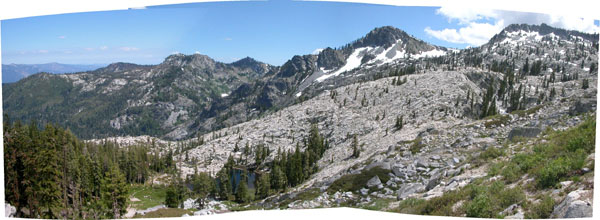
The trail emerged from the forest shade and took
us out onto the granite slope directly beneath Sugar Pine Butte.
The grand vista of blindingly white rock and snowfields was immediate
and intense. Below on the other side of the canyon lay tiny Conway
Lake surrounded by lush meadow and trees. The only obvious trail,
marked by cairns, sloped downward. We surmised that perhaps we
had to pass below a sheer granite outcropping before resuming
our climb. Following the cairns down a quarter mile through the
loose granite sand and rock, we arrived at an overlook of Lion
Lake. There the trail veered sharply downward, the cairns tracing
a path as steep as a stairway to the exposed granite bedrock in
the vee of the canyon, then up the other side into brush at Lion
Lake's outlet. This was not the way to Foster Lake.
Groaning under our burdens, we turned back and re-climbed the
talus slope just as Nancy and Margot emerged from the forest.
Bob was still puffing up the trail somewhere behind them. We explained
our plight. Fruitlessly we looked around for the trail that would
take us up, exploring a game track here and there. Where the trail
should have angled upward stood an impassible cliff of granite
bedrock. Finally we regrouped at the edge of the woods where we
had lost the trail. Our pack straps dragged down on our shoulders
with a leaden despair. The sun ducked behind a lonesome cloud,
turning our sweat cold.
"Where's Aaron?" someone asked. No one had seen him.
He was supposed to be ahead of us on the trail, but we couldn't
be sure he had successfully negotiated this maze by himself. We
called his name a few times, but only echoes replied. Hopefully
he had already found his way to Foster Lake.
As the sun returned, Mr. Popper emerged from the trees like a
lumbering freight train and trundled out onto the open slope we
had just explored. For a long moment he squinted at the bright
granite, surveying the barren mountainside. Then, with the certainty
of a Laysan Albatross returning from a 5000-mile flight over open
water, he pointed confidently to two large trees three hundred
feet above us.
"She's up there," he announced
Incredulous, we cross-examined him. How the hell did he know
the trail was up there? Could he see it? Why would the
trail go that way? Why didn't some track or trace lead
up there? With a dismissive shrug, he explained that he had gone
that way the first time he camped at Lion Lake. From across the
canyon, he had seen the trail scratched into the granite and scree
just above that grove. He had hiked up from Lion, caught the trail
there, and continued on up to the saddle overlooking Foster Lake.
He shifted his backpack painfully and began working his way up
the steep slope. And yes, those were the trees. No doubt
about it.
Doubt, however, enveloped the rest of us like a cold fog, but
armed with no better plan, we followed Mr. Popper, up through
the loose scree, white rock, and sparse brush toward his trees,
and there, lo and behold, was a definite trail ascending westward
above the granitic bulge. As we followed it, the trail grew more
defined, and we began to suspect that Mr. Popper was right. It
was, after all, from near here, at the end of the last century,
that Mr. Popper had taken his famous photo-collage of Lion and
Conway Lakes. (View
Famous Photo)
As soon as we crested the bulge, we could see the trail snaking
upward toward the divide four hundred feet above Lion Lake. Here,
hanging above a precipitous drop into the lake, the loose sand
footing grew precarious. It was probably here that the dead horse
Mr. Popper had once found in Lion Lake had lost its footing and,
tumbling, whinnied out its final breaths. God knows what became
of the rider. A nasty business, that, and we tried not to look
down as we contoured across a particularly exposed couloir.
The trail crossed the saddle above a weathered, gnarled old whitebark
pine and a massive upright slab of granite. The saddle lies at
a vortex of intersecting vistas and is one of the most spectacular
places in all the Trinity Alps. Behind us tiny Lion Lake glimmered
blue from a cleft near the head of the bedrock granite canyon
sweeping downward two thousand feet to forested Boulder Creek.
On the eastern horizon, beyond the granitic domes above Boulder
Lake, loomed snow-streaked Mount Shasta. To the north, stark ecclesiastical
facades of granite mounted upward on terraces to the unseen spires
of Sugar Pine Butte. To the south the polished white bedrock rose
from the rocky saddle to the varnished and fractured summits of
the Boulder Creek rim, which still cradled robust fields of snow.
But before us--ah! Before us Foster Lake filled a basin of fractured
rock 200 feet directly below, reflecting the green of the surrounding
forest. Beyond the lake the western rim of this granite world
dropped abruptly off into the lush forest greens and earthen reds
of the Union Creek valley 1200 feet below, as if the forces of
creation had grown weary of so much white. On the far side of
the valley rose a low range of red-rock bluffs with pink mine
tailings. This was Bullard's Basin, where the Dorleska mine had
abandoned miles of underground shafts. The Union Lake cirque lay
to the north. Beyond this swath of rusty ultramafic ridges, the
creators must have rediscovered their passion for white, for granite
rose in an imposing wave from the Caribou Mountain pluton in the
south to Packer's Peak in the north.
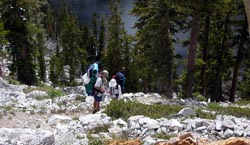 Perhaps
we tarried too long. The others had moved quickly on, and we now
lagged behind. Protecting a sore knee, I minced carefully down
the steep, rocky trail that circled inside the northeast wall
of the cirque toward Foster Lake's outlet. Tonelessly I chanted
a verse from Dylan's song, "And the first ones now, will
later be last, for the times, they are a-changing." Perhaps
we tarried too long. The others had moved quickly on, and we now
lagged behind. Protecting a sore knee, I minced carefully down
the steep, rocky trail that circled inside the northeast wall
of the cirque toward Foster Lake's outlet. Tonelessly I chanted
a verse from Dylan's song, "And the first ones now, will
later be last, for the times, they are a-changing."
We arrived at Foster Lake around 4:00 P. M., hot, weary, and
worn. We had been hiking hard for five-and-a-half hours. Aaron
was waiting at the large horse camp standing vacant on the forested
flat a hundred feet northwest of the lake's shore of jumbled rock.
He had encountered no difficulty following the trail above Lion
Lake and could not comprehend why we had. So much for the
wisdom of years.
At 7260 feet, Foster Lake is rugged, wild, and remote, and we
appeared to have it all to ourselves. Mr. Popper, as we had speculated,
selected the best campsite for himself and Nancy. Aaron set up
nearby. Margot eked out a marginally flat spot with a spectacular
view in the rocks just above the water's edge. We erected our
tent well away from the main campfire ring, close to the outlet
stream. Mr. Popper took a quick plunge in the cold water while
I built a fire in the central fire pit. Amaretto and Mountain
Margaritas again flowed freely as we prepared dinner. Later we
lay out where the smooth granite fell away to the valley far below
and watched the sun set over the western Trinities.
As an evening chill settled in from the snow banks on the south
headwall and the last light drained from the sky, we sat wearily
around the blazing fire chatting and joking, some in hammocks,
some leaning against the hemlocks. We swatted a few mosquitoes.
Margot had displayed an interest in Eastern religions (as well
as epistemologies of a more contemporary ilk), so I presented
her with his renegade doctrine of Megadeath Buddhism (see endnote).
Solemnly Margot received it, as a sort of personal koan. And why
not? Classical Zen refuses to distinguish the whimsical from the
grave. The slightest distinction, they say, opens an insurmountable
gap between heaven and earth. Whatever that means. Off
and on Margot essayed answers to her new koan. I received them
implacably, suspecting there was no answer and rather wishing
I had never brought the subject up. Stars emerged and grew bright
before we crawled into our tents and slept.

Friday morning Barbara and I arose before the others, boiled
water over a little fire, then carried our tea, coffee, and sitting
pads out to a rocky prominence overlooking the Union Creek valley.
The shadow of our mountain crept towards us across the thickly
forested valley floor, uncovering an inviting green meadow, which,
from our perch, looked like a golf course. I wanted to go there.
Maybe shoot a few holes. Just drop down the trail that we could
see snaking through the brush on the moraine below Sugar Pine
Butte. We could spend the night down in the trees somewhere along
the creek and hike out Sunday on the Union Creek trail. Maybe,
I suggested, we could talk Aaron into driving our van around to
the trailhead. The hike out Union Creek is only a half mile further
than the one back through Boulder Lakes. Barbara was game, if
Aaron was.
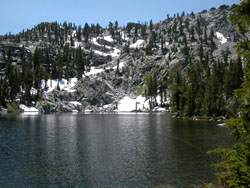 The
morning passed leisurely. Everyone was too tired to want to hike
very far. After lunch Mr. Popper and I swam in the cold water,
but not for long. Barbara took pictures of a waterfall on the
south end of the lake beneath the towering headwall, where snow
banks prevented us from walking all the way around. The day was
cooler and the mosquitos not as bad as at the creek crossing campsite.
But there were a few pesky biting black bugs. Barbara saw chickadees,
yellow-rumped warblers, and osprey, and heard Clark's nutcrackers.
In the afternoon we hiked with Mr. Popper up to a bluff overlooking
a small, unnamed lake. From the high point we could see Red Mountain
and Landers Lake, and beyond, on the Canyon Creek pluton, Thompson
Peak, Wedding Cake, and the glacier above Grizzly Lake. After
dinner we all enjoyed our last sunset overlooking the mysterious,
enticing Union Creek valley. The
morning passed leisurely. Everyone was too tired to want to hike
very far. After lunch Mr. Popper and I swam in the cold water,
but not for long. Barbara took pictures of a waterfall on the
south end of the lake beneath the towering headwall, where snow
banks prevented us from walking all the way around. The day was
cooler and the mosquitos not as bad as at the creek crossing campsite.
But there were a few pesky biting black bugs. Barbara saw chickadees,
yellow-rumped warblers, and osprey, and heard Clark's nutcrackers.
In the afternoon we hiked with Mr. Popper up to a bluff overlooking
a small, unnamed lake. From the high point we could see Red Mountain
and Landers Lake, and beyond, on the Canyon Creek pluton, Thompson
Peak, Wedding Cake, and the glacier above Grizzly Lake. After
dinner we all enjoyed our last sunset overlooking the mysterious,
enticing Union Creek valley.
I asked Aaron if he would consider driving our van over to the
Union Creek trailhead so we could hike out that way. Aaron was
open to the idea. I asked him to sleep on it and let us know in
the morning.
Saturday morning our time at Foster Lake had come to an end.
Aaron confirmed his willingness to help us. It was agreed that
we would drop down into the valley and hike out the Union Creek
trail. The others would return the way we had come and spend another
night at the Boulder Creek crossing. On Sunday Aaron would meet
us with our van at the trailhead. He thought he could get there
by 2:00 or 3:00 in the afternoon. Mr. Popper would drive Aaron's
Isuzu out.
Thrilled at the unique chance for a through-hike, Barbara and
I packed up after breakfast. We would descend the slope into something
new, a valley Barbara had never seen. To suddenly be able
to leap out of the rut of the exact same hike we had done four
years ago, spectacular as the setting might be, into the unknown,
was exhilarating. Not knowing what we might find. Not knowing
where we would camp. True, I had once hiked up Union Creek to
Foster Lake, but that was almost twenty-five years ago, when backpacking
had been new, and I no longer remembered much of it. I slipped
a neoprene support over my left knee to guard against irritating
an old basketball strain. We strapped on our packs and bid Foster
Lake and our friends farewell.
The trail zig-zagged down the steep, rocky moraine through short
manzanita, huge granite boulders, and sparse patches of timber.
Near the bottom we entered the forest and snaked around huge trunks
until we arrived at a crossing of the stream flowing out of Foster
Lake. The stream is called Union Creek. The stream that flows
out of Union Lake, less than a mile to the southwest, is not
named Union Creek. Although it flows into Union Creek, it is not
even a "fork" of Union Creek. It has no name. Go figure.
We changed into our tennis shoes and waded across the cold, narrow,
deep, swiftly rushing water and climbed through an opening in
the willows on the far bank to the promised land.
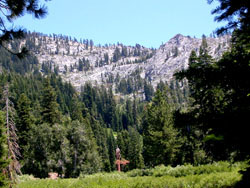 The
meadow, of course, was not a golf course, but a field of
knee-high bunch grass, corn lilies, and low, wispy flowering plants
whose prickly seeds clung to our socks when we wandered off the
trail. It was lovely, with a Morris Meadow-like ambiance. In the
moist mixture of granitic glacial till and rusty ultramafic soil
grew giant ponderosa pines, red fir, and stately incense cedar,
and along the creek, cottonwood, willow, and alder. We stopped
for awhile in the shade of a stately Ponderosa pine and took in
the views, from the daunting granite fortress rising up to Foster
Lake and Sugar Pine Butte to the red rock mountains to the north
and west, all lapped by an ocean of trees. Soon we would enter
the forest and our vistas would be submerged in the narrowing
Union Creek canyon. We paused to drink our fill before that happened. The
meadow, of course, was not a golf course, but a field of
knee-high bunch grass, corn lilies, and low, wispy flowering plants
whose prickly seeds clung to our socks when we wandered off the
trail. It was lovely, with a Morris Meadow-like ambiance. In the
moist mixture of granitic glacial till and rusty ultramafic soil
grew giant ponderosa pines, red fir, and stately incense cedar,
and along the creek, cottonwood, willow, and alder. We stopped
for awhile in the shade of a stately Ponderosa pine and took in
the views, from the daunting granite fortress rising up to Foster
Lake and Sugar Pine Butte to the red rock mountains to the north
and west, all lapped by an ocean of trees. Soon we would enter
the forest and our vistas would be submerged in the narrowing
Union Creek canyon. We paused to drink our fill before that happened.
We resumed hiking, quickly crossed the large meadow, and entered
a dwindling series of pocket meadows. The forest closed in. The
trail sloped gently downward. The creek moved away to the right.
Through the trees we could see that we were passing a high cliff
into Bullard's Basin, and when we entered we immediately encountered
a trail junction. A sign bolted to a tree pointed west to "Dorleska
Mine" and "Big Flat." Three years ago, the summer
after our first trip to Foster Lake and my hip replacement, Barbara
and I had started at Big Flat, at the other end of this trail,
and hiked up to the top of the ridge to look back at Foster Lake
and down on the Dorleska Mine. Small world.
Below the junction, things felt different. Subtly, but profoundly,
the wilderness changed character. Above the junction, our trails
had traced the contour of the land, where game tracks had evolved
into Indian paths, into mule pack routes, and into maintained
wilderness trails. But below Bullard's Basin, and for the rest
of the way out, industrialized man had left his heavy boot print.
A road had been rudely gouged into the bank above the creek to
service the Dorleska mine. Rocky and rough, the road had been
abandoned and was narrowed by slides and the slow encroachment
of the forest.
The road was an infected splinter, and the taint of illness radiated
out on both sides. Signs were obvious in some places, hidden in
others: a rotting stump, a coil of wire cable in the tall grass,
a rusting piece of broken machinery, an eroding skid trail, a
washout spilling rock into the creek, a stunted forest of unnaturally
even new growth.
True, other areas of the Trinity Alps contained artifacts of
man's intrusion. Remnants of a wooden flume still snake down the
North Forks of Coffee Creek, and a crumbling rock dam still raises
the water level of Emerald Lake a few feet. These artifacts are
curious, benign, and of little lasting impact. But this road,
this scar, this sore, had opened the gates of exploitation, allowing
mining and major logging of the wild land. Virgin nature had been
pillaged and raped, and though the road was now closed, the deeper
scars would take centuries to heal.
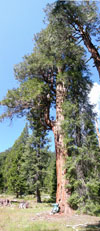 Probably
five miles down from Foster Lake, a major creek flowing out of
Bullard's Basin had washed out the road. Leaving the trail, we
followed the upstream bank down to a broad, high flat of open
moraine watched over by a few ancient incense cedars. There, in
the tall dry grass, we decided to set up camp. Although we found
evidence of an overgrown fire ring, no one had camped there for
a long time. We erected our tent on the grassy flat high above
the creek, but hung our hammocks and built a cooking fire down
in the cool, deep channel cut by the creek, a little above its
confluence with Union Creek. The creek bed was a jumble of granite,
peridotite, serpentine, and cherts, with a spritely current splashing
over and around the rounded rocks and boulders. All had been washed
from the long tongue of moraine deposited in the canyon floor. Probably
five miles down from Foster Lake, a major creek flowing out of
Bullard's Basin had washed out the road. Leaving the trail, we
followed the upstream bank down to a broad, high flat of open
moraine watched over by a few ancient incense cedars. There, in
the tall dry grass, we decided to set up camp. Although we found
evidence of an overgrown fire ring, no one had camped there for
a long time. We erected our tent on the grassy flat high above
the creek, but hung our hammocks and built a cooking fire down
in the cool, deep channel cut by the creek, a little above its
confluence with Union Creek. The creek bed was a jumble of granite,
peridotite, serpentine, and cherts, with a spritely current splashing
over and around the rounded rocks and boulders. All had been washed
from the long tongue of moraine deposited in the canyon floor.
After dinner we hiked down to the confluence. The steep slope
on the other side of Union Creek had been heavily logged and eroding
skid roads cut into the near bank. That evening we saw an olive-sided
flycatcher and mountain bluebirds, but would encounter no other
humans until the afternoon of the following day.
Sunday, our final day, we broke camp and hiked out through forest
of incense cedar, with flowers along trail. The road was rocky
and eroded by storm flows below Bullard's Basin. We were each
a different person from the one who had hiked up the road to Boulder
Creek that first morning. More at peace. More self-reliant. More
in tune with the wildness from which we all emerged.
A mile or two from our destination the trail crossed Union Creek
high on a wood-decked, steel-girder bridge. When I had last come
this way twenty-five years ago a twisted wreck of truss bridge
had spanned the creek, crushed by the winter's avalanche of snow.
It had been replaced. At the east end we found a few good campsites,
with more probably down along both sides of the boulder-strewn
river bed.
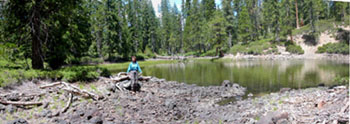 The
final stretch of trail climbed up and away from the creek and
over a ridge. Here the road was wide and well-defined and had
probably been used to haul in those massive bridge girders. Ponderosa
pine and a few rare Brewer Spruce offered their shade. Near the
summit we met a man and woman leading six young llamas strung
in single file and heading in for their very first trip to Union
Lake. Strange, curiously intelligent animals, the llamas were.
Hiking a little further, tired and hot, we came upon a small,
stagnant, one-acre lake amid the peridotite and azaleas beside
the road. We could not find it on the map. Ahead of the time line,
we stopped for lunch and a swim in the shallow green waters. We
took our time and watched a redbreasted nuthatch nearby. The
final stretch of trail climbed up and away from the creek and
over a ridge. Here the road was wide and well-defined and had
probably been used to haul in those massive bridge girders. Ponderosa
pine and a few rare Brewer Spruce offered their shade. Near the
summit we met a man and woman leading six young llamas strung
in single file and heading in for their very first trip to Union
Lake. Strange, curiously intelligent animals, the llamas were.
Hiking a little further, tired and hot, we came upon a small,
stagnant, one-acre lake amid the peridotite and azaleas beside
the road. We could not find it on the map. Ahead of the time line,
we stopped for lunch and a swim in the shallow green waters. We
took our time and watched a redbreasted nuthatch nearby.
As we started down the switchback road toward the parking lot,
we tried to raise Aaron on the radio. Nothing. As we neared the
bottom, Aaron pulled in with our van. We could see him walking
below, and finally got a response on the radio. "You're just
getting here? Really?" The timing verged on
precision.
On the way out the narrow, dusty Coffee Creek Road, Mr. Popper,
driving up in Aaron's Isuzu, nearly side-swiped us. He, Nancy,
and Margot had come to see how the recovery was going. Aaron rode
with us while the others followed in his vehicle until we rendezvoused
at the LaGrange Cafe in Weaverville for dinner and to swap tales
of the last two days. We shared with them our final conclusions:
Union Creek is the gentler, easier way to get to Foster Lake,
but the Boulder Creek route is by far the more scenic. Nothing,
however, tops a through-hike and its illusion that you are going
somewhere, not just walking in circles.
ENDNOTE: ON MEGADEATH BUDDHISM
The Buddhist position on reincarnation is that one must go through
many cycles of birth, living, and death. Rebirth, in Buddhism
and in other early Indian systems of liberation, is seen as horrific.
Buddhism expresses the overriding urgency of the need to escape
from the cycle of rebirth. After many such cycles, if a person
is able to release his attachment to desire and the self, he can
attain Nirvana.
But modern technology offers us a shortcut, undreamed of by the
ancients, a quick and dirty route to Nirvana. By means of well-placed
nuclear warheads, we now have the ability not only to eradicate
all forms of life, but to render the earth uninhabitable. Thus
can we forevermore release all sentient beings from the wheel
of birth and death.
Return to Backpacking
in Jefferson
|